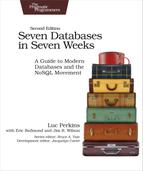Chapter
2
PostgreSQL
PostgreSQL is the hammer of the database world. It’s commonly understood, often readily available, and sturdy, and it solves a surprising number of problems if you swing hard enough. No one can hope to be an expert builder without understanding this most common of tools.
PostgreSQL (or just “Postgres”) is a relational database management system (or RDBMS for short). Relational databases are set-theory-based systems in which data is stored in two-dimensional tables consisting of data rows and strictly enforced column types. Despite the growing interest in newer database trends, the relational style remains the most popular and probably will for quite some time. Even in a book that focuses on non-relational “NoSQL” systems, a solid grounding in RDBMS remains essential. PostgreSQL is quite possibly the finest open source RDBMS available, and in this chapter you’ll see that it provides a great introduction to this paradigm.
While the prevalence of relational databases can be partially attributed to their vast toolkits (triggers, stored procedures, views, advanced indexes), their data safety (via ACID compliance), or their mind share (many programmers speak and think relationally), query pliancy plays a central role as well. Unlike some other databases, you don’t need to know in advance how you plan to use the data. If a relational schema is normalized, queries are flexible. You can start storing data and worrying about how exactly you’ll use it later on, even changing your entire querying model over time as your needs change.
